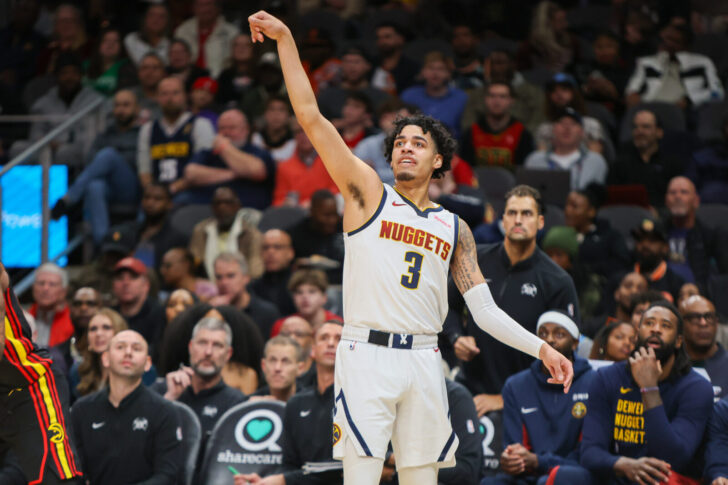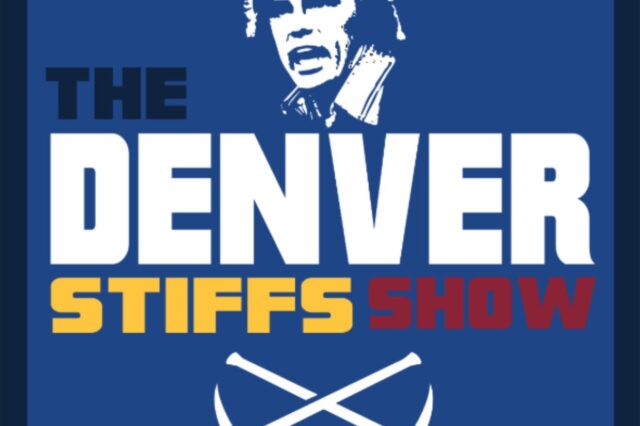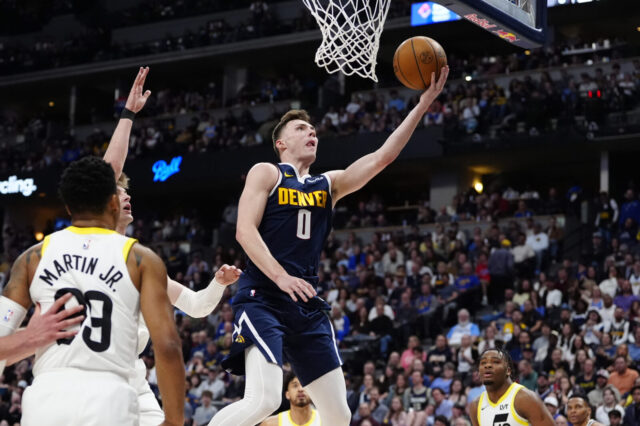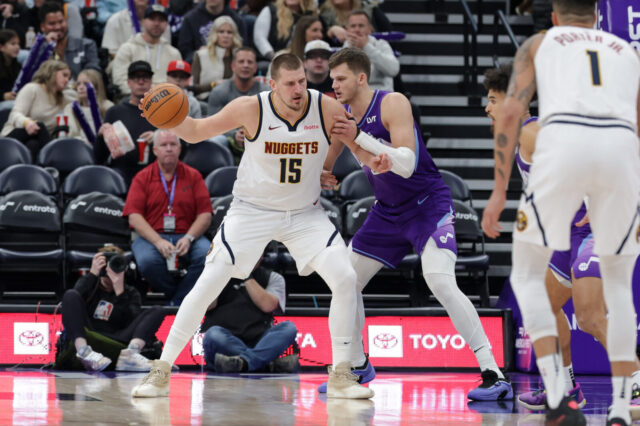
Dec 11, 2023; Atlanta, Georgia, USA; Denver Nuggets guard Julian Strawther (3) shoots against the Atlanta Hawks in the second quarter at State Farm Arena. Mandatory Credit: Brett Davis-USA TODAY Sports
The Nuggets have had an interesting offseason, and by interesting I mean that they have done things that not many contenders have done before them. They let one of their best veterans walk, and now are relying on three guys on their rookie contracts to fill the void left by Kentavious Caldwell-Pope’s departure. Those three obviously being Christian Braun, Peyton Watson, and the focus of this article – Julian Strawther.
The Nuggets acquired Julian Strawther in the 2023 NBA Draft with the 29th pick of the 1st round. Calvin Booth traded the Nuggets’ 2029 1st rounder for that pick, and it’s not the first time he’s made a move like that. In 2022, he traded the Nuggets’ 2027 1st and JaMychal Green for the pick that ended up being Peyton Watson. In today’s trade economy, first round picks are the most exchanged assets. Want a role player? One first round pick please. Oh, you want a star? That’ll be three firsts plus one of your young guys, thank you very much.
The Nuggets currently don’t have many assets to trade outside of these young guys, so while it’s uncommon to have to put expectations on a 29th overall pick going into their second year on a contender – here we are. Julian Strawther is going to have to play well. He’s going to have to be able to close some games in all likelihood. The Nuggets don’t have a Justin Holiday to fall back on this season. Their backups would be either Russell Westbrook, who is already the backup point guard, or Trey Alexander who is on a two-way contract and therefore ineligible to play in the playoffs. So, unless the Nuggets want to free up a roster spot and convert Trey Alexander to a standard contract – it’s Strawther or bust.
When he was drafted, Strawther was lauded for his shooting ability. He had good touch indicators – a good floater, he improved his 3 point percentage and volume every year he was at Gonzaga, shot 77.6% from the charity stripe as a junior, and 40.8% on over 5 attempts a game. His shot mechanics also indicated he’d be a good shooter. The way he jumped into his shots, got them up quick, the confidence that she shot with – it all said he’d be a great shooter. Then why did he shoot 29.7% from beyond the arc in his rookie season? Why did he shoot 36.9% from the field? Are we sure he can contribute? Well, let’s take a look shall we?
Julian Strawther had a lot of flashes last season. His best game came early in the season against the Atlanta Hawks on December 11th of 2024. In that game he put up 22 points and 5 steals on 8/16 from the field, including 6/11 shooting from the 3 point line. He looked dynamic, and he had been getting fairly consistent minutes for the better part of that season. The Hawks game was the 24th game of the season, and through that game, Strawther had only sat in 3 of them.
In the 21 he did play, he averaged 13 minutes per game. Not a huge amount of minutes, but enough to show that he warranted some looks. Looks that Michael Malone was happy to give to him. In those minutes, he averaged 5.5 points per game on 52.1 TS% (True shooting percentage is an efficiency metric that accounts for 3 pointers and free throws, weighing them more for efficiency than normal field goal percentage). I use true shooting here because the majority of Strawther’s shots came from 3 pointers. Of the 5.1 shots per game he took in this first part of the season, 3.4 were 3 pointers. He was shooting 34.7% on those shots.
It wasn’t the best efficiency, but it was enough to think that as he got better throughout the year that in time he would get that up to potentially 36-38%. On that volume that would be a great asset to a team that lacked in the shooting department, especially on a bench unit consisting of a group with no one being a particularly good shooter. Off the back of the Hawks game, he saw an uptick in playing time. He got 15.4 minutes per game over the next 12 games. The shot stopped falling as much, but Malone didn’t go away from him. It seemed he was willing to let Strawther find his rhythm again. Then he got injured.
He sustained an ankle injury that held him out for the next month. By the time he returned, the team had simply fallen into rhythm with a different rotation. From the time he returned on February 9th to the end of the regular season, he made 3 3 pointers…total. Half of what he made in the Hawks game over a 3 month span. Most of his appearances were cameos in blowouts. He played less than 5 minutes in 12 of his 17 games over that period. He shot 17.4% from beyond the arc and 29.7% from the field. That’s good for a 39.5% TS%, compared to the 50% TS% he put up before that.
Now, 50% isn’t good. The league average for shooting guards last season was 57.1%, leaving Strawther well below that mark. However, that 50% is far better than the 39.5% he put up for the rest of the season. As Kyle Kuzma once said, “It’s hard to be consistent in an inconsistent role.” So, yeah, he didn’t do great, but there’s a reason behind that. He still showed the ability to hit shots in some games – the mechanics and confidence were still there.
Now that we’ve covered what he’s done up until this point – let’s try and project a bit. See what the Nuggets might expect from Strawther this season. After parsing through some stats, I came up with some criteria to see player profiles similar to Julian Strawther’s rookie season. He shot 12.5 3 pointers per 100 possessions, and 29.7% from 3. So I looked for rookies that shot at least 12 3 pointers per 100 possessions, and shot worse than 31% from 3. It painted a fairly grim picture. The best player, at least by win shares, was P.J. Hairston.
It looked too bad for me to assume that’s where Julian Strawther would end up, so I expanded it to 32% from deep. Then it added Jared Butler as the best player. I then decided to expand it to include 2nd year guys, and lo and behold it added one more player to the top of the list – Luka Doncic. Therefore, Julian Strawther will be – yeah, let me stop. Strawther I think will land somewhere in the middle of this spectrum. He absolutely will not be Luka Doncic, but I also think he will be better than P.J. Hairston. A couple of players who almost fit the criteria (lowered the 3 point attempts per 100 to 10 for this) are encouraging though.
One that popped up was Aaron Nesmith. In his second season, he shot 27% from 3. He also shot 10 3 pointers per 100, so that gives us a similar profile to Strawther as far as stats go. He’s also more comparable in role to what Strawther likely will be instead of point guards like Jared Butler.
After that season he jumped to 36.6% from 3, and while he saw a decline in his volume, he became a more effective shooter. This is because he went from having a spotty role in Boston to being a regular rotation player for the Pacers. I think that Strawther will see a similar jump when he gets regular minutes. The way he gets into his shot, jumping into it, getting it off as quick as he does – it’s all things that only elite shooters do.
Every shooter has their off days, Strawther may have had an off year, but soon enough we’ll see him bloom and start to thrive as a shooter. As far as anything besides that, it remains to be seen. There’s too small of a sample size to tell whether he’ll be able to create his own shots at all, and there’s not much to bank on for him being a good defender. His role will probably be to provide spacing to a bench unit that will need it, seeing as it will have both Russell Westbrook and Peyton Watson on it. He’ll need to be a lynchpin offensively for the Nuggets, and while it’s a lot of pressure to put on a second year player, I think he’s got what it takes to step up.


